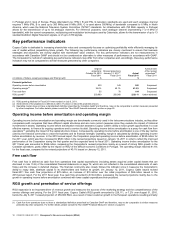Cogeco 2011 Annual Report Download - page 21
Download and view the complete annual report
Please find page 21 of the 2011 Cogeco annual report below. You can navigate through the pages in the report by either clicking on the pages listed below, or by using the keyword search tool below to find specific information within the annual report.20 COGECO CABLE INC. 2011 Management’s Discussion and Analysis (MD&A)
iv. IAS 36 – Impairment of assets:
For the purposes of impairment testing, IFRS requires that assets be grouped into cash generating units (“CGUs”). IFRS then
requires a one-step approach whereby the carrying value of the CGUs is compared to the higher of fair value less costs to sell and
the value in use. Canadian GAAP required grouping at the lowest level of independent cash flows and used a two-step approach for
impairment testing whereby the carrying values were first compared to the undiscounted future cash flows in order to determine the
existence of an impairment, and subsequently compared to the fair value to determine the amount of the impairment.
IFRS also requires the reversal of a previous impairment loss on assets other than goodwill in the event a change in circumstances
indicates that the impairment no longer exists or has decreased.
The Corporation has tested its CGUs at the date of transition to IFRS and no impairment was identified. In addition, the impairment
of goodwill and fixed assets recorded under Canadian GAAP in the third quarter of fiscal 2011 would have been the same under
IFRS.
v. IAS 38 – Intangible assets:
Intangible assets with indefinite lives are not amortized under IFRS or Canadian GAAP. However, IFRS requires full retrospective
application, including the reversal of amortization which was not reversed under the transitional provisions of Canadian GAAP.
On transition to IFRS, the Corporation will reverse all amortization recorded on intangible assets with indefinite lives. The impact will
increase intangible assets by an amount of approximately $50.8 million, increase future income tax liabilities by an amount of
approximately $7.6 million and increase opening retained earnings by an amount of approximately $43.2 million, on the opening
IFRS balance sheet.
vi. IFRS 3 – Business combinations:
Acquisition-related costs, which the Corporation capitalized under Canadian GAAP, are expensed under IFRS. In accordance with
the IFRS 1 election described above, the Corporation will apply the requirements of IFRS 3 prospectively from the date of transition.
As part of the application of IFRS 3, the Corporation will be required to expense acquisition-related costs capitalized on acquisitions
completed since the date of transition to IFRS. The application of IFRS 3 to the business acquisitions completed in fiscal 2011 will
increase operating costs by an amount of $2.3 million, reduce future income tax expense by an amount of $0.1 million and reduce
goodwill at August 31, 2011 by an amount of $2.2 million.
Also as a result of the IFRS 1 election described above, the Corporation will be required to reverse the retroactive adjustment to
intangible assets acquired in prior business acquisition stemming from the recognition of future income taxes upon application of
CICA Handbook section 3465, Income taxes. As a result, intangible assets will be decreased by an amount of approximately
$73.3 million, future income tax liabilities by an amount of approximately $61.8 million and retained earnings by an amount of
approximately $11.5 million.
vii. IAS 39 – Financial instruments: recognition and measurement:
The criteria and method used for assessing hedge effectiveness may be different under IFRS compared to Canadian GAAP.
Upon transition to IFRS, the Corporation will continue to apply hedge accounting under IFRS to all hedging arrangements which the
Corporation recorded under Canadian GAAP. The hedging documentation and hedge effectiveness tests have been updated and
conform to the requirements of IAS 39. As a result, it is expected that there will be no impact on the opening IFRS balance sheet and
on fiscal 2011 operating results.
viii. IAS 23 – Borrowing costs:
IFRS requires that borrowing costs be capitalized on qualifying assets purchased or constructed by the entity. Canadian GAAP
permitted a policy choice to capitalize or expense these costs, which the Corporation elected to expense.
In light of the Corporation’s election under IFRS 1, this difference will have no impact on the Corporation’s opening IFRS balance
sheet. Borrowing costs will be capitalized on any qualifying assets purchased or constructed after the date of transition to IFRS. The
application of IAS 23 in fiscal 2011 will reduce financial expense and increase fixed assets by an amount of approximately
$0.5 million.
ix. IAS 12 – Income taxes:
Recognition and measurement criteria for deferred tax assets and liabilities may differ. IFRS also requires that temporary differences
relating to current assets and current liabilities be presented as non-current liabilities and non-current assets, whereas these were
classified as current under Canadian GAAP. The impact of retrospective application of IAS 12 will increase future income tax
liabilities and decrease opening retained earnings by an amount of approximately $41 million.
























